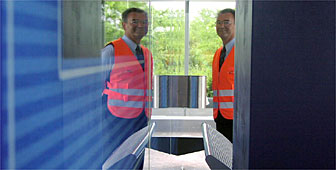Local stations get a facelift

Over 600 regional train stations in Switzerland are being updated in a new project to make them safe and easy to use.
Swiss Federal Railways has invested SFr340 million in the scheme, which will bring an end to the old 19th-century wooden stations, and replace them with modern glass shelters.
The first new station was officially opened in the little town of Muntelier-Löwenberg in canton Fribourg. Christian Kräuchi, who is head of communications for Swiss Federal Railways, said the new project was an indication of the importance of the regional rail network.
“Eighty per cent of our passengers use the local trains,” Kräuchi told swissinfo. “Either for commuting, or to connect to the main network. The regions are very important in Switzerland, we don’t want a rail system that just connects the big cities.”
Clean, safe, and easy to use
The philosophy behind the new stations is that passengers should feel comfortable, and familiar with their surroundings, wherever they are. So the 619 new structures are basically the same.
Architect Daniel Messerli, whose firm beat 200 other applicants in order to get the contract for the renovation, said that while all the stations had the same facilities, they would not be identical.
“Basically it’s a bit like lego,” Messerli told swissinfo. “You can build them in all different shapes and sizes.”
The new stations are made almost entirely of glass, behind which there are panels showing travel scenes, or just colours in the railways’ traditional red and blue.
There is an automated ticket machine, and an electronic board displaying the latest departures and arrivals. There is also a small glass waiting room, and full timetables and bus and tram connections, again, displayed behind glass. It’s hoped that using so much glass will help prevent graffiti.
“We want the passengers to feel comfortable,” said Messerli. “And they have let us know that they want a station which is clean, safe, and easy to use.”
No staff, and few toilets
But there will be no staff at the new stations, and, at Muntelier Löwenberg at least, there is no toilet. Christian Kräuchi says having staff at every local station is just too expensive.
“We simply can’t afford it any more,” Kräuchi explained. “If we had a station master at every station, as we used to, we would have to close some railway lines to pay for them and we don’t want to do that.”
Instead each station is equipped with an emergency button, which will connect passengers to railway staff at larger stations. And lighting plays a very important role in the new station concept too.
“Actually I think I’m proudest of the lighting,” said Daniel Messerli. “The best way to see these new stations is at night, the lighting is clear and bright, but not harsh.”
The trademark of each of the new stations will be an eight to ten metre high pillar of light, affectionately dubbed the “rail pillar”, which will allow passengers to identify the nearest local station even from some distance away.
Swiss love their trains
Over 80 of the new stations should be ready by the end of this year, and all 619 will be renovated by 2006. The multi-million franc investment in so many small local stations is a sign of just how loyal the Swiss remain to their railway network.
“We have 800,000 passengers every day,” Christian Kräuchi explained. “Or over 300 million every year. In fact the Swiss are the most frequent train travellers in the world after Japan.”
And the Swiss railway network is also one of the best supported financially, receiving more public money per head of population than any other country in Europe.
Just this week, the Swiss senate approved a new funding plan, which will give the railways over six billion francs over the next four years. Much of the money is likely to be spent on upkeep of track and trains, further development of infrastructure, and extension of the existing network.
By Imogen Foulkes

In compliance with the JTI standards
More: SWI swissinfo.ch certified by the Journalism Trust Initiative
You can find an overview of ongoing debates with our journalists here. Please join us!
If you want to start a conversation about a topic raised in this article or want to report factual errors, email us at english@swissinfo.ch.